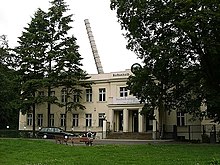


Great refractor refers to a large telescope with a lens, usually the largest refractor at an observatory with an equatorial mount. The preeminence and success of this style in observational astronomy defines an era in modern telescopy[1] in the 19th and early 20th century.[1] Great refractors were large refracting telescopes using achromatic lenses (as opposed to the mirrors of reflecting telescopes). They were often the largest in the world, or largest in a region. Despite typical designs having smaller apertures than reflectors, great refractors offered a number of advantages and were popular for astronomy.[1] It was also popular to exhibit large refractors at international exhibits, and examples of this include the Trophy Telescope at the 1851 Great Exhibition, and the Yerkes Great Refractor at the 1893 World's Fair in Chicago.
A great refractor was often the centerpiece of a new 19th century observatory, but was typically used with an entourage of other astronomical instruments such as a Meridian Circle, a Heliometer, an Astrograph, and a smaller refractor such as a Comet Seeker or Equatorial. Great refractors were often used for observing double stars and equipped with a Filar micrometer. Pioneering work on astrophotography was done with great refractors.[2]
An example of prime achievements of refractors, over 7 million people have been able to view through the 12-inch Zeiss refractor at Griffith Observatory since it opened in 1935; this is the most people to have viewed through any telescope.[3] In modern times many large refractors have become important historical items, and are often used for public astronomy outreaches. However, many have also been shut down or moved due to their difficulty of use as telescopes. Whereas in the modern era aperture and location are important, the older style observatories were often located near towns because astronomy was only one function; major tasks were simply to record the weather, make accurate determinations of location, and to determine the local time. In modern times many of these functions are performed elsewhere and communicated locally.
Some noted accomplishments of refractors were the discovery of Neptune, the discovery of the Moons of Mars, and the compilation of various star catalogs. A derivative instrument of refractors, the heliometer was used to measure for the first time the distance to another star by geometric parallax in the mid-1800s. As telescopes became larger and longer, the relatively modest increases in aperture belied their enormous size, with moving weights in the multiple tons in domes several stories tall; physically many of the biggest were larger than even some modern reflecting telescopes.
- ^ a b c "Era: Great Refractors". Amazing-space.stsci.edu. Retrieved 2014-03-01.
- ^ "Harvard College Observatory: Great Refractor". Cfa.harvard.edu. 2012-11-21. Retrieved 2014-03-01.
- ^ "Zeiss Telescopes - Griffith Observatory - Southern California's gateway to the cosmos!".